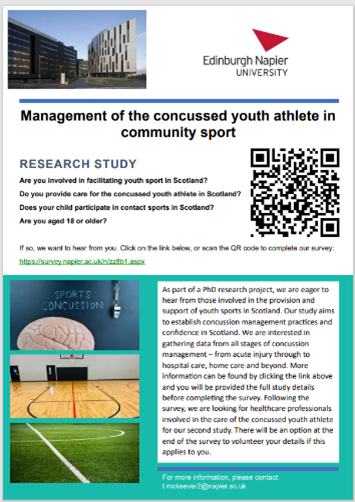Introduction
My name is Tom McKeever and I am a second year PhD student at Edinburgh Napier University and also a practicing physiotherapist. I also lecture on the MSc Physiotherapy programme, supporting the training of aspiring physiotherapists. My PhD research field is in the medical and pathway management of the concussed youth athlete in Scotland. I am currently running all my major PhD studies, working with youth athletes, and aiming to scope the ‘state of play’ for concussion management of our youth sportspersons.
The aim of my research is to explore the challenges of grass roots concussion management, and hopefully target future research/ interventions to help support the effective brain health management of our youth sports persons in Scotland. Participating in my research is a unique opportunity to contribute to our understanding of how we manage concussions in the community. To find out more, scan the QR code in the study advert, or click this link:
https://survey.napier.ac.uk/n/zz8b1.aspx
What is a concussion?
A concussion is defined as: “A traumatic brain injury that is defined as a complex pathophysiological process affecting the brain, induced by biomechanical forces”.[1] Concussions (also known as mild traumatic brain injuries – mTBI) account for a large proportion of total brain injuries. There is limited worldwide data on concussion prevalence. However, in the US it is estimated that approx. 3.8 million sports related TBIs occur annually.[2] Concussions can occur with or without a loss of consciousness and can be hard to diagnose, as CT and MRI scans often show no structural changes.[3] New and developing technologies to assist with concussion diagnosis are being researched but are not yet definitive or scientifically robust (salivary and blood-based biomarkers).[4]
Click here to read a recent BJSM blog on biomarkers writing by myself and Dr. David Hamilton: Is it scientifically valid, sensible, or safe to use biomarkers to diagnose concussion? – BJSM blog – social media’s leading SEM voice (bmj.com)
Why is research important?
There is growing concern that repetitive hits to the head during contact sports contribute towards catastrophic long-term consequences for athletes. Our evolving scientific understanding of mTBI pathology and the consequences of such injuries is proving to be somewhat alarming. Chronic traumatic encephalopathy (CTE) is a condition that is associated with long-term repetitive head injuries and impacts.[5] CTE is a form of progressive brain disease and can only be diagnosed during an autopsy after death. During the lifespan of a person with evolving CTE, they can begin to experience symptoms of memory loss, confusion, significant mood changes and mental health problems.[6] Several studies have found evidence to suggest the risk of dementia and neurodegenerative disease is increased in those with a history of a mild traumatic brain injury mTBI/concussion.[7,8,9] And researchers are continuing to investigate dementia risk in retired footballers and have published a protocol for their ongoing FIELD study.[10] There is no doubt that we should be concerned about the long-term impacts of repetitive head injuries and as the evidence mounts, there remains growing pressure on sport’s governing bodies to address these concerns.
There have, however, been positive steps in improving the management of a concussed athlete and in April 2023, the UK Government published its ‘landmark’ concussion guidance for grassroots sport, in which there was improved weighting on the worthy sentiment ‘If in doubt, sit them out’.[11] In other good news, the Sports Concussion Assessment Tool (SCAT-6) was recently published, and its use encouraged for baseline testing, and following suspected concussion injury for supporting concussion diagnosis.[12] This assessment tool can be utilised by healthcare professionals as a tool to establish disturbance to the cognitive and physical functioning of an athlete, and to establish symptom progression, recovery and subjective and objective outcomes following a concussion.
Sport participation is key to keeping young people active, and yields physical, mental and social benefits. However, effective concussion management is crucial if we are to protect the brain health of our youth sports persons in Scotland. Not only in the short term, but the long term too. We must effectively educate our youth sports stakeholders on the importance of brain health management and include youth sportspersons in these discussions. Whilst positive steps have been taken, and Scotland has led the way in terms of management protocols, we still have a long way to go.
Grassroots sports is posed with unique challenges when it comes to injury and brain health management, as often community club funding does not allow for specialist medical support. My research aims to establish Scotland-wide, the current levels of concussion management support and provision for community sports clubs. I hope to work and collaborate with many institutions, clubs and individuals over the coming years, to improve best practice care for our youth sports persons in Scotland and focus my efforts to support dementia prevention strategies that align with my research.
Please do get in touch if you have any questions or would like to find out more about my work
Contributor Tom McKeever BSc (Hons). MCSP. MHCPC.

Recent blog publication: Is it scientifically valid, sensible, or safe to use biomarkers to diagnose concussion? – BJSM blog – social media’s leading SEM voice (bmj.com)
Please take a look at my active research study
https://survey.napier.ac.uk/n/zz8b1.aspx
References:
- McCrory, P., Feddermann-Demont, N., Dvořák, J., Cassidy, J. D., McIntosh, A., Vos, P. E., Echemendia, R. J., Meeuwisse, W., & Tarnutzer, A. A. (2017). What is the definition of sports-related concussion: a systematic review. British journal of sports medicine, 51(11), 877-887. Https://doi:10.1136/bjsports-2016-097393
2. Langlois, J. A., & Sattin, R. W. (2005). Traumatic brain injury in the United States: Research and programs of the Centers for Disease Control and Prevention (CDC)-Preface. Journal of Head Trauma Rehabilitation, 20(3), 187-188. Https://doi.10.1056/NEJMoa1908483
3. Brody, D. L. (2019). Concussion care manual. Oxford University Press, USA. Available at: Concussion Care Manual – David L. Brody – Google Books
4. Tabor J B, Brett B L, Nelson L, et al. Role of biomarkers and emerging technologies in defining and assessing neurobiological recovery after sport-related concussion: a systematic review. British journal of sports medicine 2023;57(12):789-797. doi:10.1136/bjsports-2022-106680
5. Bieniek, K. F., Cairns, N. J., Crary, J. F., Dickson, D. W., Folkerth, R. D., Keene, C. D., … & TBI/CTE Research Group Babcock Debra MD, PhD Bellgowan Patrick PhD Crane Paul MD Edlow Brian MD Huber Bertrand Russ MD, PhD Kiernan Patrick MD Koroshetz Walter MD. (2021). The second NINDS/NIBIB consensus meeting to define neuropathological criteria for the diagnosis of chronic traumatic encephalopathy. Journal of Neuropathology & Experimental Neurology, 80(3), 210-219. https://doi:10.1093/jnen/nlab001
6. Pierre, K., Dyson, K., Dagra, A., Williams, E., Porche, K., & Lucke-Wold, B. (2021). Chronic traumatic encephalopathy: update on current clinical diagnosis and management. Biomedicines, 9(4), 415. https://doi.org/10.3390/biomedicines9040415
- 7. Lee, Y. K., Hou, S. W., Lee, C. C., Hsu, C. Y., Huang, Y. S., & Su, Y. C. (2013). Increased risk of dementia in patients with mild traumatic brain injury: a nationwide cohort study. PloS one, 8(5), e62422. https://doi.org/10.1371/journal.pone.0062422
8. Russell, E. R., Mackay, D. F., Lyall, D., Stewart, K., MacLean, J. A., Robson, J., … & Stewart, W. (2022). Neurodegenerative disease risk among former international rugby union players. Journal of Neurology, Neurosurgery & Psychiatry, 93(12), 1262-1268. https://doi.org/10.1136/jnnp-2022-329675
9. Mackay, D. F., Russell, E. R., Stewart, K., MacLean, J. A., Pell, J. P., & Stewart, W. (2019). Neurodegenerative disease mortality among former professional soccer players. New England Journal of Medicine, 381(19), 1801-1808. https://DOI:10.1056/NEJMoa1908483
10, Russell, E. R., Stewart, K., Mackay, D. F., MacLean, J., Pell, J. P., & Stewart, W. (2019). Football’s InfluencE on Lifelong health and Dementia risk (FIELD): protocol for a retrospective cohort study of former professional footballers. BMJ open, 9(5). https://doi.org/10.1136/bmjopen-2018-028654
11, UK Government. If in doubt, sit them out. UK Concussion guidelines for non-elite (grassroots) sport [online]. 2003. http://sramedia.s3.amazonaws.com/media/documents/9ced1e1a-5d3b-4871-9209-bff4b2575b46.pdf
12. Echemendia R J, Brett B L, Broglio S, et al. Sport concussion assessment tool™–6 (SCAT6). British journal of sports medicine 2023;57(11): 622-631. https://doi:10.1136/bjsports-2023-107036


